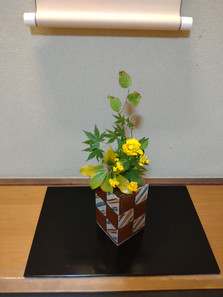Autumn🍂opening the "ro"
- 高橋宗真

- Dec 19, 2023
- 2 min read
Updated: Dec 29, 2023
In November, when the autumn-like days continue, we opened the “ro” (sunken hearth). Starting in November, the position of the kettle will change from the “furo” (brazier) to “ro”, bringing the kettle closer to the guests.
The sound of hot water and steam feel close to you, conveying warmth.
The hanging scroll is "関"(kan). In the sense of checkpoit, it means to practice again with a new feeling. This is a Zen word suitable for opening the “ro”.
(Top photo)
At the end of the tea procedure, the utensils are displayed on the stand. This is an arrangement that decorates the “ro” opening every year.
The “natsume” (tea container) is lacquered "Un-Kin" (it means cherry blossoms and colored leaves) made by Izumo Lacquer Shikko-sai. It expresses the color of autumn. The tea scoop is named "Chitose" (a thousand year) made by Myo-do. It is made from old temple bamboo.
The tea bowl is a "picture of ivy" (Shiun in Kyoto). The “mizusashi” is colored with "Grape Shelf" (Tokusen in Kyoto).
The sweets are "Yakumo-mochi" made by the Japanese confectionery shop "Chimoto" in Meguro.This popular dish is made of soft rice cake wrapped in thin bamboo skin and is easy to eat.
In November, there was a tea ceremony at the Goto Museum of Art, and tea utensils from the museum's collection, such as the hanging scroll handwritten by Oribe Furuta and the black Oribe tea bowl, were used during the tea ceremony, which reopened for the first time in four years after the coronavirus outbreak.
The exhibition features "Old Iga pottery" from the Momoyama period to the early Edo period in 16th-17th century, such as flower vases and “mizusashi”.
It was a sunny bright autumn day, and I felt the history of tea. (Bottom photo)
























Comments